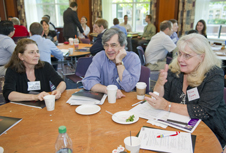Bringing the ‘human element’ to engineering

The United States’ floundering health-care system, which wastes some $760 billion each year, is among the country’s biggest challenges, said industrial engineering and operations research professor professor James Benneyan, director of Northeastern’s health-care systems engineering program.
Speaking at the Health Care Improvement Scholars Meeting in the Raytheon Amphitheater on Wednesday, Benneyan told some 75 physicians, postdoctoral students and patient-safety fellows of the New England Veterans Engineering Resource Center, “The health-care system is broken and in a state of crisis. It’s a train wreck waiting to happen.”
The two-day conference focused on solving the health-care crisis by using the principles of systems engineering to optimize treatment, patient safety and quality of care. Northeastern’s health-care systems engineering program — which aims to improve efficiency, safety and access to health care in much the same way airline companies optimize their operations — sponsored the event.
A number of students in the program presented cost-cutting mathematical solutions for allocating medical resources, optimizing hospital inventory and designing physicians’ daily schedules. As Benneyan put it, “Seventy percent of all problems can be solved with basic methods that offer continuous quality improvement.”
Benneyan also directs the engineering resource center and National Science Foundation-funded Center for Health Organization Transformation, a multi-university health-care systems engineering research center that conducts applied research on solutions to problems of common interest throughout the field.
David Luzzi, dean of the College of Engineering, praised Northeastern students and faculty for using engineering principals to solve the health-care crisis. “It’s really great to bring the human element into engineering,” he said.
Physicians, research fellows and directors of patient-safety programs who attended the conference said engineering models could help cure the ailing health-care system.
“Using engineering concepts in practical ways to improve patient safety makes a lot of sense,” said Peter Mills, the director of the field office for the VA National Center for Patient Safety, in White River Junction, Vermont.
Tom Rust, a research fellow for the engineering resource center who made a presentation on the Veterans Affairs compensation and pension process, agreed.
“The presentations provided a good mix of case study and theory,” he said. “Engineering tools could be used in many different areas of a hospital.”
Problems in health-care, he said, must be solved using interdisciplinary methods. “Most problems and solutions, including safety, cost and quality of care, are silent,” Rust said. “We’ll get better results if we form a multidisciplinary response to these problems.”
Clinicians must be made aware of the benefits of tackling health-care from an engineering point of view, said Tricia Woodhead, a physician from England on a one-year fellowship for the Institute for Health-care Improvement.
“We have to remember that health-care is about people,” she said, “not about machines.”





